Numerical Investigation of Reinforced Concrete (RC) Columns Strengthened with Ultra-High-Performance Fiber-Reinforced Concrete (UHPFRC) Jackets
Abstract
:1. Introduction
2. Numerical Modeling of Columns Strengthened with RC Jackets
3. Numerical Modeling of Columns Strengthened with UHPFRC Jackets
3.1. Experimental Evaluation of UHPFRC Properties and Numerical Modeling
3.2. RC Column Prior to and after Strengthening with UHPFRC Jackets
3.2.1. Effect of UHPFRC Jacket Thickness
3.2.2. Effect of Addition of Steel-Reinforcing Bars in UHPFRC Jackets
3.2.3. Effect of UHPFRC Jacket Shrinkage
4. An Evaluation of the Effectiveness of the Use of UHPFRC Jackets and Comparisons with the Use of Conventional RC Jackets
5. Conclusions
- ▪
- The thickness of the UHPFRC jacket significantly affects the stiffness and the ultimate load capacity, which increase as the jacket’s thickness is increased. The ultimate load capacity is increased by 2.6–3.8 times for UHPFRC thicknesses of 25 mm–75 mm compared to the respective load of the initial (prior to strengthening) RC column.
- ▪
- The addition of steel bar reinforcement to the UHPFRC jackets leads to a significantly greater load capacity enhancement. In the case of the RC column strengthened with the 75 mm thick UHPFRC jacket, an ultimate load capacity of 131 kN was achieved and this value was further increased to 220 kN (68% increment) by the addition of steel bars to the UHPFRC jacket.
- ▪
- UHPFRC jacket shrinkage leads to a reduction in the ultimate load capacity of the strengthened columns due to the development of tensile stresses in a direction normal to the loading condition and a subsequent biaxial stress state. A reduction in the ultimate load of almost 15% was observed for an imposed shrinkage strain of 800 microstrains. The detrimental effect of the concrete shrinkage is limited by the presence of steel-reinforcing bars in the UHPFRC jackets.
- ▪
- The comparison of UHPFRC jackets with traditional RC jackets shows that the use of UHPFRC leads to greater stiffness enhancement compared to the respective results of the column strengthened with the RC jacket. The highest load enhancement was achieved for columns strengthened with the UHPFRC jacket with steel bars, where the ultimate load was found to be 6.4 times higher than the load of the initial column. In the case of the RC jacket and the UHPFRC jacket (without additional steel bars), the ultimate load increments were found to be equal to 4.8 and 3.8, respectively.
Author Contributions
Funding
Institutional Review Board Statement
Informed Consent Statement
Data Availability Statement
Conflicts of Interest
References
- Bett, B.J.; Klingner, R.E.; Jirsa, J.O. Lateral load response of strengthened and repaired reinforced concrete columns. ACI Struct. J. 1988, 85, 499–508. [Google Scholar]
- Bracci, J.M.; Reinhorn, A.M.; Mander, J.B. Evaluation of Seismic Retrofit of RC Frame Structures: Part II. Experimental Performance and Analytical Study of a Retrofitted Structural Model; Technical Report No. NCEER-92-0031; State University of New York at Buffalo, National Center for Earthquake Engineering Research: Buffalo, NY, USA, 1992. [Google Scholar]
- Ersoy, U.; Tankut, A.T.; Suleiman, R. Behaviour of jacketed columns. ACI Struct. J. 1993, 90, 288–293. [Google Scholar]
- Rodriguez, M.; Park, R. Seismic load tests of reinforced concrete columns strengthened by jacketing. ACI Struct. J. 1994, 91, 150–159. [Google Scholar]
- Stoppenhagen, D.R.; Jirsa, J.O.; Wyllie, L.A. Seismic repair and strengthening of a severely damaged concrete frame. ACI Struct. J. 1995, 92, 177–187. [Google Scholar]
- Dritsos, S.E.; Taylor, C.A.; Vandoros, K.G. Seismic strengthening of reinforced concrete structures by concrete jacketing. In Proceedings of the 7th International Conference on Structural Faults and Repair, Edinburgh, UK, 8 July 1997. [Google Scholar]
- Dritsos, S.E.; Vandoros, K.G.; Taylor, C.A. Shaking table tests on a retrofitted, small scale, reinforced concrete model. In Proceedings of the 6th SECED Conference on Seismic Design Practice into the Next Century, Oxford, UK, 26–27 March 1998. [Google Scholar]
- Gomes, A.M.; Appleton, J. Repair and strengthening of reinforced concrete elements under cyclic loading. In Proceedings of the 11th European Conference on Earthquake Engineering, Paris, France, 6–11 September 1998. [Google Scholar]
- Julio, E.S. Influence of the Interface on the Behavior of Columns Strengthened by Reinforced Concrete Jacketing. Ph.D. Dissertation, University of Coimbra, Coimbra, Portugal, 2001. (In Portuguese). [Google Scholar]
- Julio, E.S.; Branco, F.; Silva, V.D. Reinforced concrete jacketing—Interface influence on monotonic loading response. ACI Struct. J. 2005, 102, 252–257. [Google Scholar]
- Julio, E.S.; Branco, F.; Silva, V.D. Reinforced concrete jacketing—Interface influence on cyclic loading response. ACI Struct. J. 2008, 105, 471–477. [Google Scholar]
- Vandoros, K.G. Experimental Investigation of the Behavior of Columns Strengthened with Reinforced Concrete Jackets under Cyclic Loads. Ph.D. Dissertation, University of Patras, Patras, Greece, 2005. (In Greek). [Google Scholar]
- Vandoros, K.G.; Dritsos, S.E. Interface treatment in shotcrete jacketing of reinforced concrete columns to improve seismic performance. J. Struct. Eng. Mech. 2006, 23, 43–61. [Google Scholar] [CrossRef]
- Vandoros, K.G.; Dritsos, S.E. Concrete jacket construction detail effectiveness when strengthening RC columns. Constr. Build. Mater. 2008, 22, 264–276. [Google Scholar] [CrossRef]
- Bousias, S.; Biskinis, D.; Fardis, M.; Spathis, A.L. Strength, stiffness and cyclic deformation capacity of concrete jacketed members. ACI Struct. J. 2007, 104, 521–531. [Google Scholar]
- Lampropoulos, A.P.; Dritsos, S.E. Concrete Shrinkage Effect on Columns Strengthened with Concrete Jackets. Struct. Eng. Int. 2010, 20, 234–239. [Google Scholar] [CrossRef]
- Lampropoulos, A.P.; Dritsos, S.E. Modelling of RC Columns Strengthened with RC Jackets. Earthq. Eng. Struct. Dyn. 2011, 40, 1689–1705. [Google Scholar] [CrossRef]
- Lampropoulos, A.P.; Tsioulou, O.T.; Dritsos, S.E. Monolithic coefficient values for design when seismically strengthening RC columns with jackets. J. Earth. Eng. 2012, 16, 1023–1042. [Google Scholar] [CrossRef]
- Mazzuca, P.; Pisani, B.; Firmo, J.P.; Ombres, L. Tensile and bond properties at elevated temperatures of a PBO-FRCM composite system for strengthening concrete elements: Experimental and analytical investigations. Constr. Build. Mater. 2024, 432, 136519. [Google Scholar] [CrossRef]
- Belal, M.; Mohamed, H.M.; Morad, S.A. Behavior of reinforced concrete columns strengthened by steel jacket. Hous. Build. Nat. Res. Cent. (HBRC) J. 2015, 11, 201–212. [Google Scholar] [CrossRef]
- Richard, P.; Cheyrezy, M. Composition of Reactive Powder Concretes. Cem. Concr. Res. 1995, 25, 1501–1511. [Google Scholar] [CrossRef]
- Rossi, P.; Arca, A.; Parant, E.; Fakhri, P. Bending and Compressive Behaviours of a New Cement Composite. Cem. Concr. Res. 2005, 35, 27–33. [Google Scholar] [CrossRef]
- Tayeh, B.A.; Abu Bakar, B.H.; Megat Johari, M.A.; Voo, Y.L. Evaluation of Bond Strength between Normal Concrete Substrate and Ultra High Performance Fiber Concrete as a Repair Material. Proc. Procedia Eng. 2013, 54, 554–563. [Google Scholar] [CrossRef]
- Hassan, A.; Jones, S.; Mahmud, G. Experimental test methods to determine the uniaxial tensile and compressive behaviour of Ultra High Performance Fibre Reinforced Concrete (UHPFRC). Constr. Build. Mater. 2012, 37, 874–882. [Google Scholar] [CrossRef]
- Kang, S.T.; Lee, Y.; Park, Y.D.; Kim, J.K. Tensile fracture properties of an Ultra High Performance Fiber Reinforced Concrete (UHPFRC) with steel fiber. Comp. Struct. 2010, 92, 61–71. [Google Scholar] [CrossRef]
- Yoo, Y.; Shin, H.O.; Yang, J.M.; Yoon, Y.S. Material and bond properties of Ultra High Performance Fiber Reinforced Concrete with micro steel fibers. Comp. Part B Eng. 2013, 58, 122–133. [Google Scholar] [CrossRef]
- Kang, S.T.; Kim, J.K. The relation between fiber orientation and tensile behavior in an Ultra High Performance Fiber Reinforced Cementitious Composites (UHPFRCC). Cem. Conc. Res. 2011, 41, 1001–1014. [Google Scholar] [CrossRef]
- Park, J.J.; Yoo, D.Y.; Kim, S.; Kim, S.W. Benefits of synthetic fibers on the residual mechanical performance of UHPFRC after exposure to ISO standard fire. Cem. Concr. Compos. 2019, 104, 103401. [Google Scholar] [CrossRef]
- Huang, B.T.; Wu, J.Q.; Yu, J.; Dai, J.G.; Leung, C.K. High-strength seawater sea-sand Engineered Cementitious Composites (SS-ECC): Mechanical performance and probabilistic modelling. Cem. Concr. Compos. 2020, 114, 103740. [Google Scholar] [CrossRef]
- Larsen, I.L.; Thorstensen, R.T. The influence of steel fibres on compressive and tensile strength of ultra high performance concrete: A review. Constr. Build. Mater. 2020, 256, 119459. [Google Scholar] [CrossRef]
- Yang, J.; Chen, B.; Su, J.; Xu, G.; Zhang, D.; Zhou, J. Effects of fibers on the mechanical properties of UHPC: A review. J. Traffic Transp. Eng. Engl. 2022, 9, 363–387. [Google Scholar] [CrossRef]
- Ravichandran, D.; Prem, P.R.; Kaliyavaradhan, S.K.; Ambily, P.S. Influence of fibers on fresh and hardened properties of Ultra High Performance Concrete (UHPC)—A review. J. Build. Eng. 2022, 57, 104922. [Google Scholar] [CrossRef]
- You, X.M.; Lin, L.B.; Fu, B.; Xiang, Y. Ultra-high performance concrete reinforced with macro fibres recycled from waste GFRP composites. Case Stud. Constr. Mater. 2023, 18, e02120. [Google Scholar] [CrossRef]
- Tanarslan, H.M. Flexural strengthening of RC beams with prefabricated ultra high performance fibre reinforced concrete laminates. Eng Struct. 2017, 151, 337–348. [Google Scholar] [CrossRef]
- Lampropoulos, A.; Paschalis, S.; Tsioulou, O.; Dritsos, S. Strengthening of reinforced concrete beams using ultra high-performance fibers reinforced concrete (UHPFRC). Eng Struct. 2015, 106, 370–384. [Google Scholar] [CrossRef]
- Paschalis, S.; Lampropoulos, A. Investigation of key parameters affecting the use of Ultra-High Performance Fiber Reinforced Concrete (UHPFRC) as strengthening material. Structures 2024, 62, 106257. [Google Scholar] [CrossRef]
- Dagenais, M.A.; Massicotte, B. Cyclic behavior of lap splices strengthened with ultra high performance fiber-reinforced concrete. J. Struct. Eng. 2017, 143, 04016163. [Google Scholar] [CrossRef]
- Ramachandra Murthy, A.; Karihaloo, B.L.; Priya, D.S. Flexural behavior of RC beams retrofitted with ultra-high strength concrete. Constr. Build. Mater. 2018, 175, 815–824. [Google Scholar] [CrossRef]
- Al-Osta, M.; Isa, M.; Baluch, M.; Rahman, M. Flexural behaviour of reinforced concrete beams strengthened with ultra-high performance fiber reinforced concrete. Constr. Build. Mater. 2017, 134, 279–296. [Google Scholar] [CrossRef]
- Safdar, M.; Takashi Matsumoto, T.; Kakuma, K. Flexural behavior of reinforced concrete beams repaired with ultra high performance fiber reinforced concrete (UHPFRC). Compos. Struct. 2016, 157, 448–460. [Google Scholar] [CrossRef]
- Farhat, F.A.; Nicolaides, D.; Kanelopoulos, A.; Karihaloo, B.L. High performance fibre-reinforced cementitious composite (CARDIFRC)—Performance and application to retrofitting. Eng. Fract. Mech. 2007, 74, 151–167. [Google Scholar] [CrossRef]
- Bruhwiler, E.; Denarie, E. Rehabilitation of concrete structures using Ultra-High Performance Fibre Reinforced Concrete. In Proceedings of the Second International Symposium on Ultra High Performance, Kassel, Germany, 5–7 March 2008. [Google Scholar]
- Yin, H.; Teo, W.; Shirai, K. Experimental investigation on the behaviour of reinforced concrete slabs strengthened with ultra-high performance concrete. Constr. Build. Mater. 2017, 155, 463–474. [Google Scholar] [CrossRef]
- Elsayed, M.; Tayeh, B.; Elmaaty, M.; Aldahshoory, A. Behaviour of RC columns strengthened with Ultra-High Performance Fiber Reinforced concrete (UHPFRC) under eccentric loading. J Build. Eng. 2022, 47, 103857. [Google Scholar] [CrossRef]
- Davdar, S.A.; Mostofinejad, D.; Bahmani, H. Strengthening of RC columns by ultra-high performance fiber reinforced concrete (UHPFRC) jacketing. Constr. Build. Mater. 2020, 235, 117485. [Google Scholar]
- Lampropoulos, A.; Paschalis, S.; Dritsos, S. UHPFRC versus RC jackets for the seismic upgrade of columns. In Proceedings of the IABSE Conference: Structural Engineering: Providing Solutions to Global Challenges, Geneva, Switzerland, 23–25 September 2015. [Google Scholar]
- Cervenka, V.; Jendele, L.; Cervenka, J. ATENA Program Documentation: Part 1 Theory; Cervenka Consulting Ltd.: Prague, Czech Republic, 2013. [Google Scholar]
- CEB-FIP Model Code 1990; Thomas Telford: London, UK, 1993.
- BS EN 12390-3:2019; TC Testing Hardened Concrete Compressive Strength of Test Specimens. British Standards Institution: London, UK, 2019.
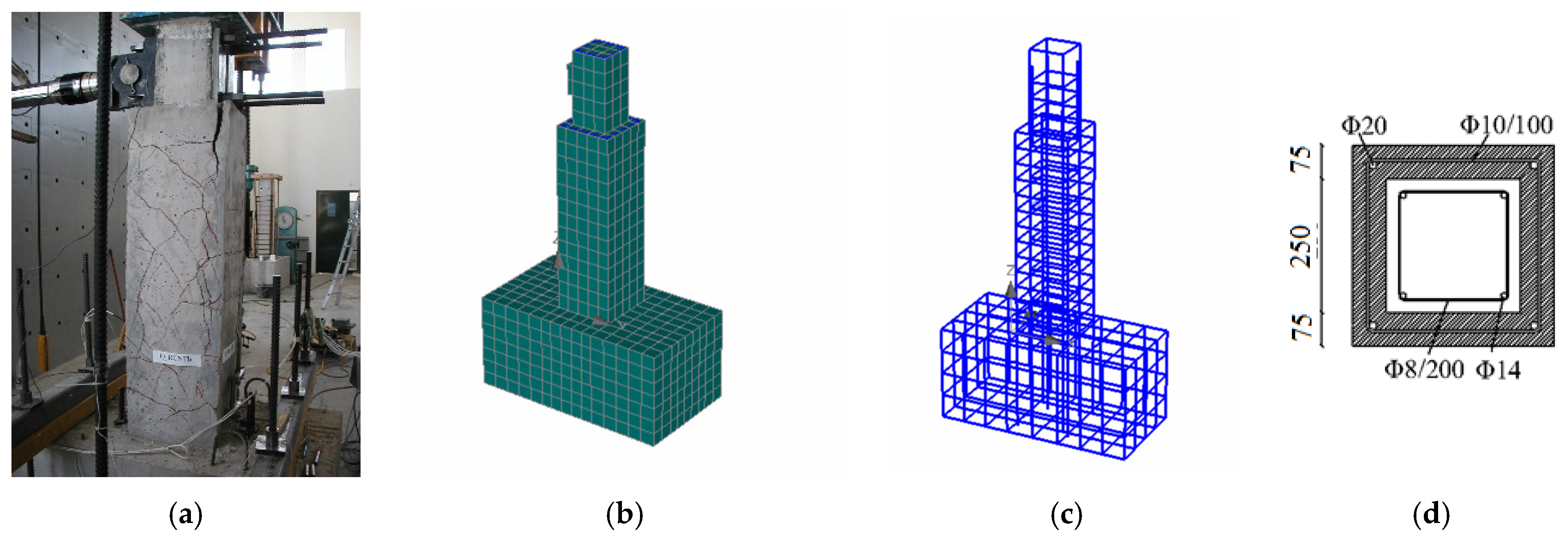
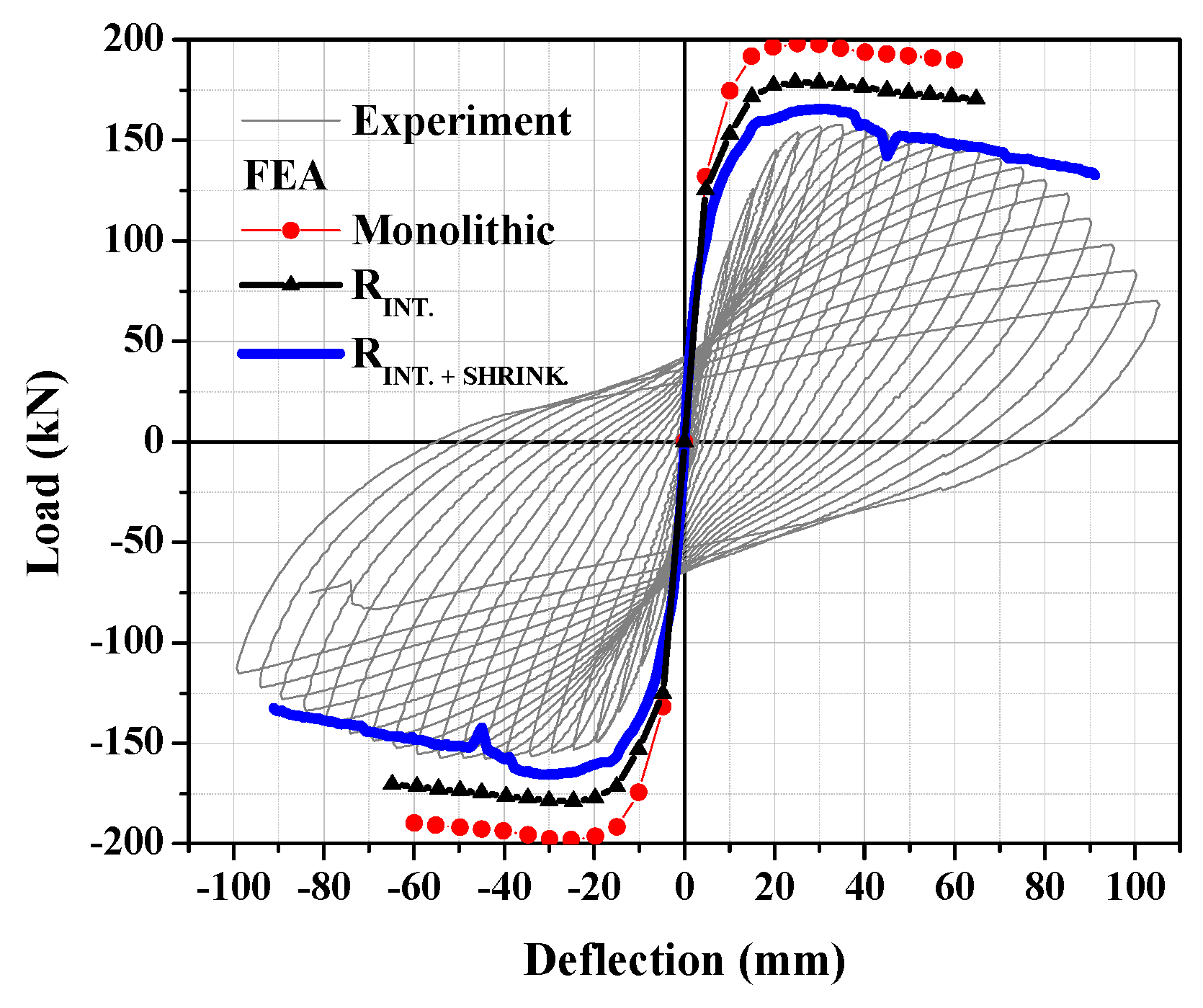

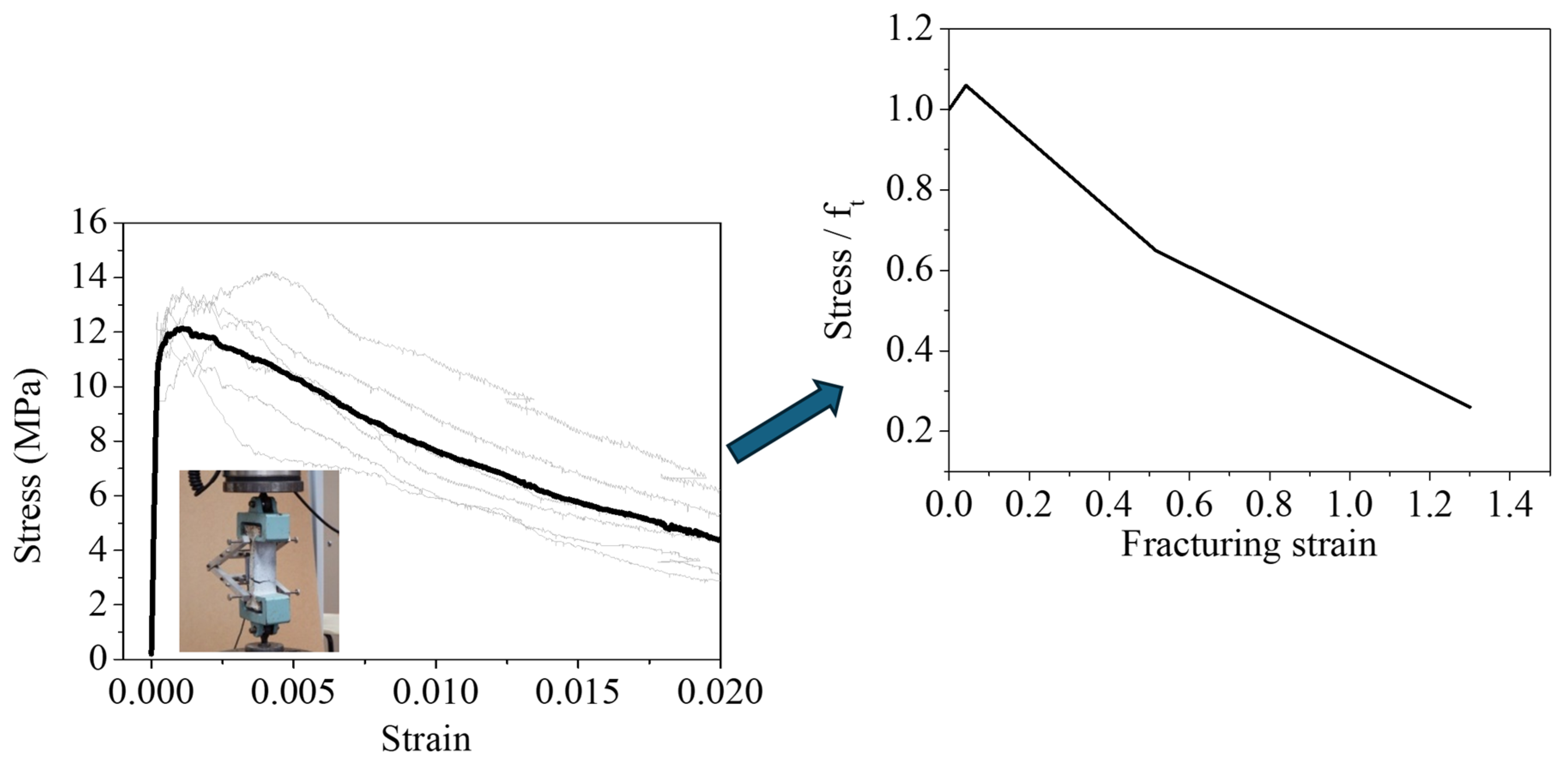
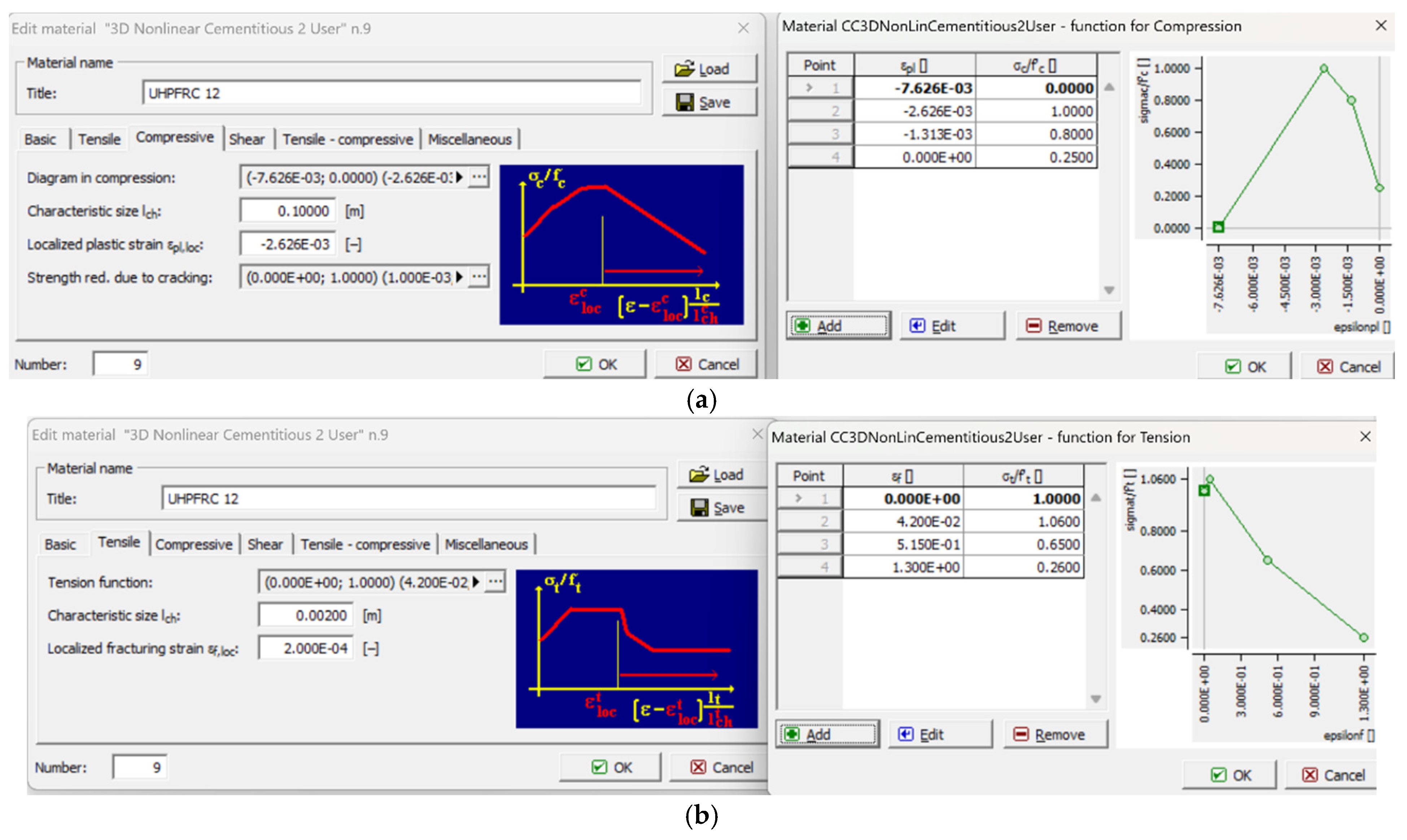
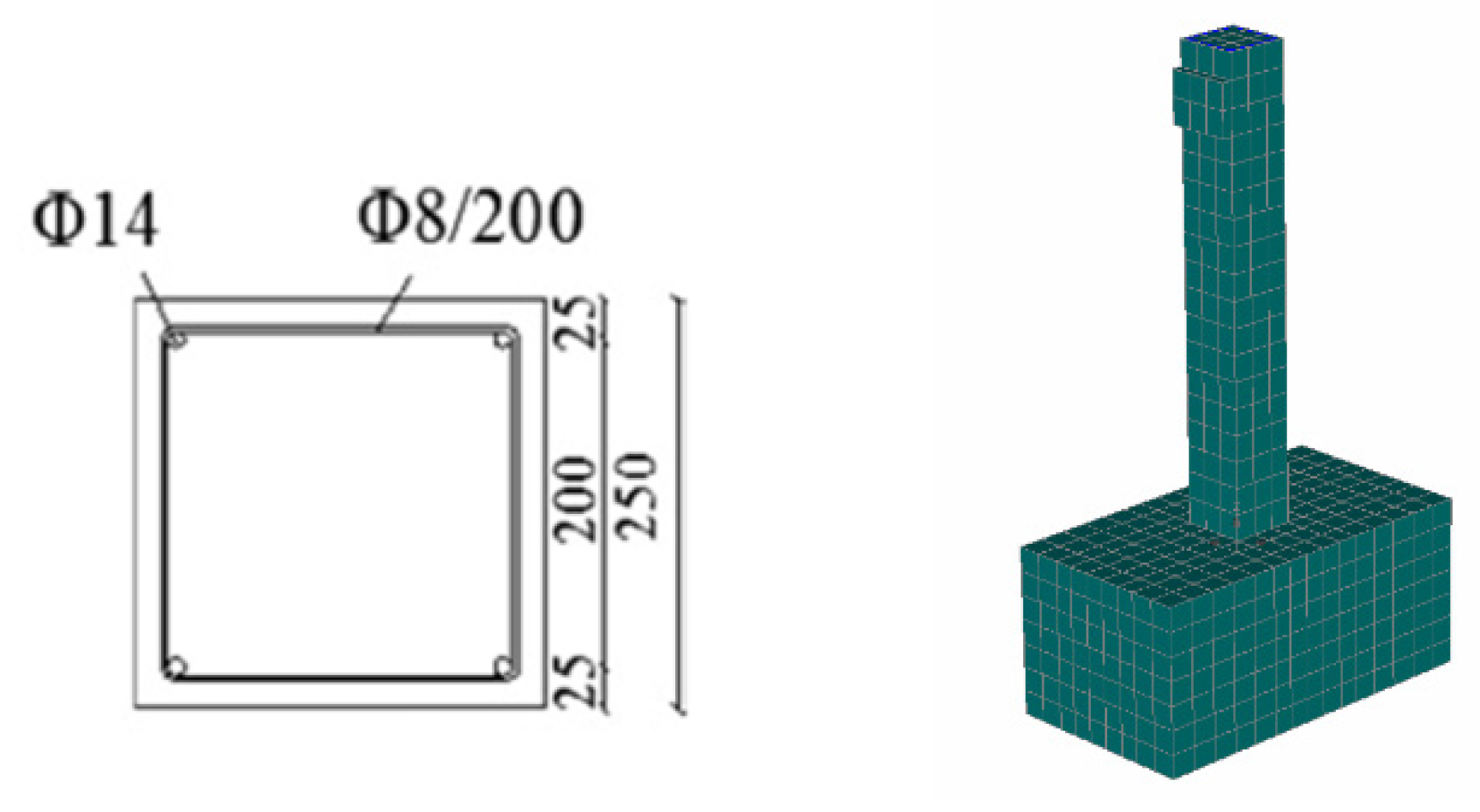

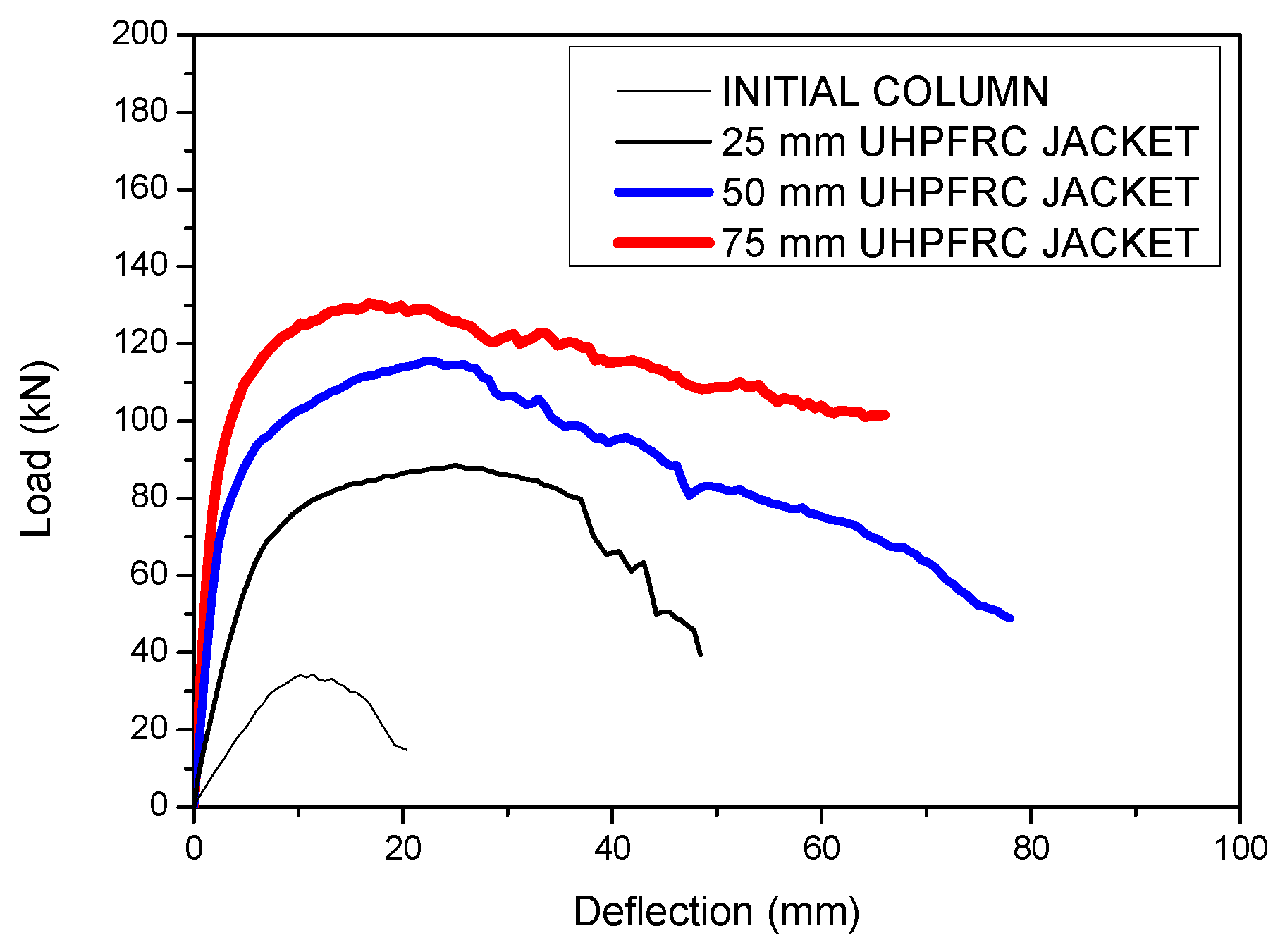


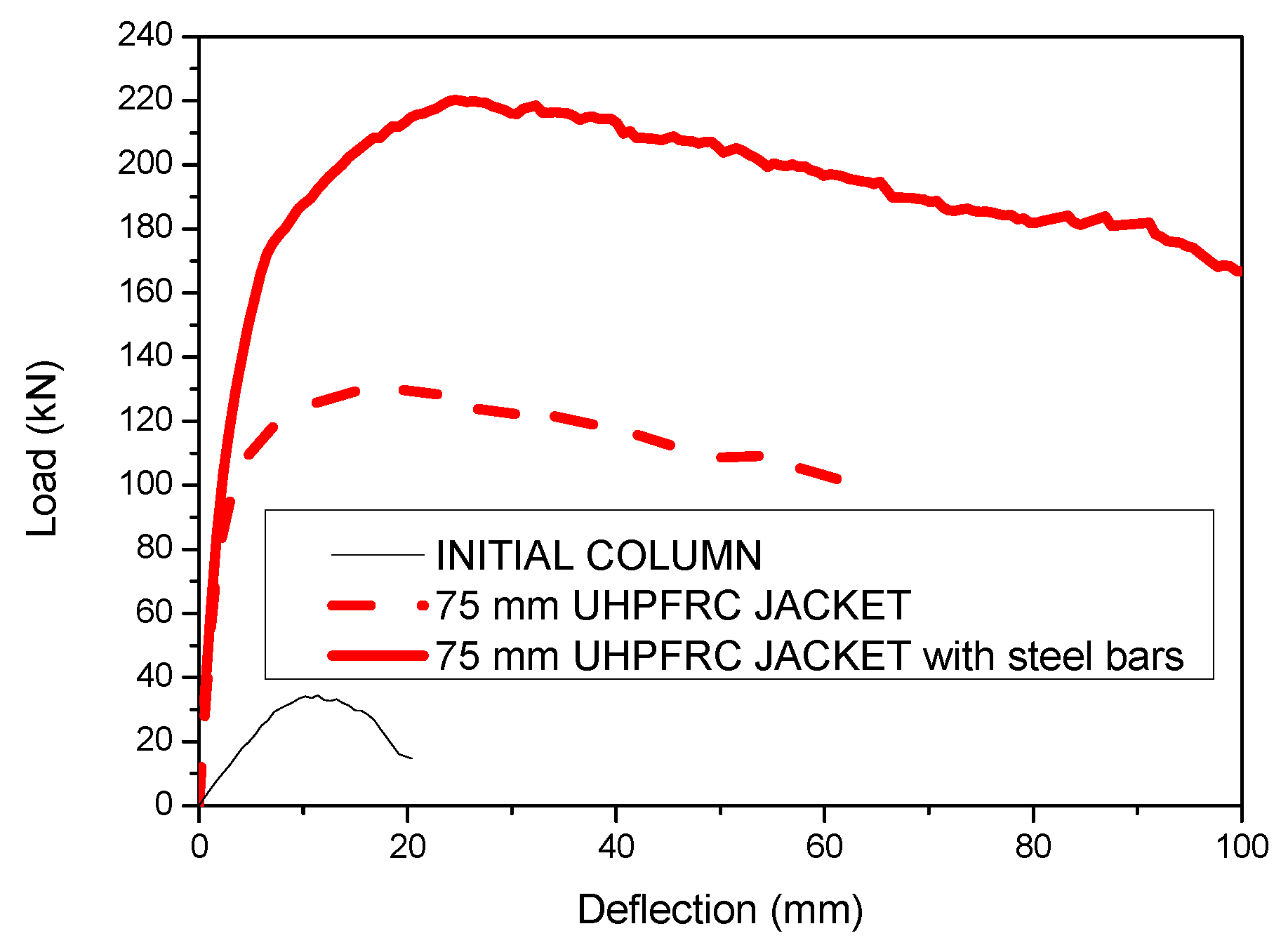
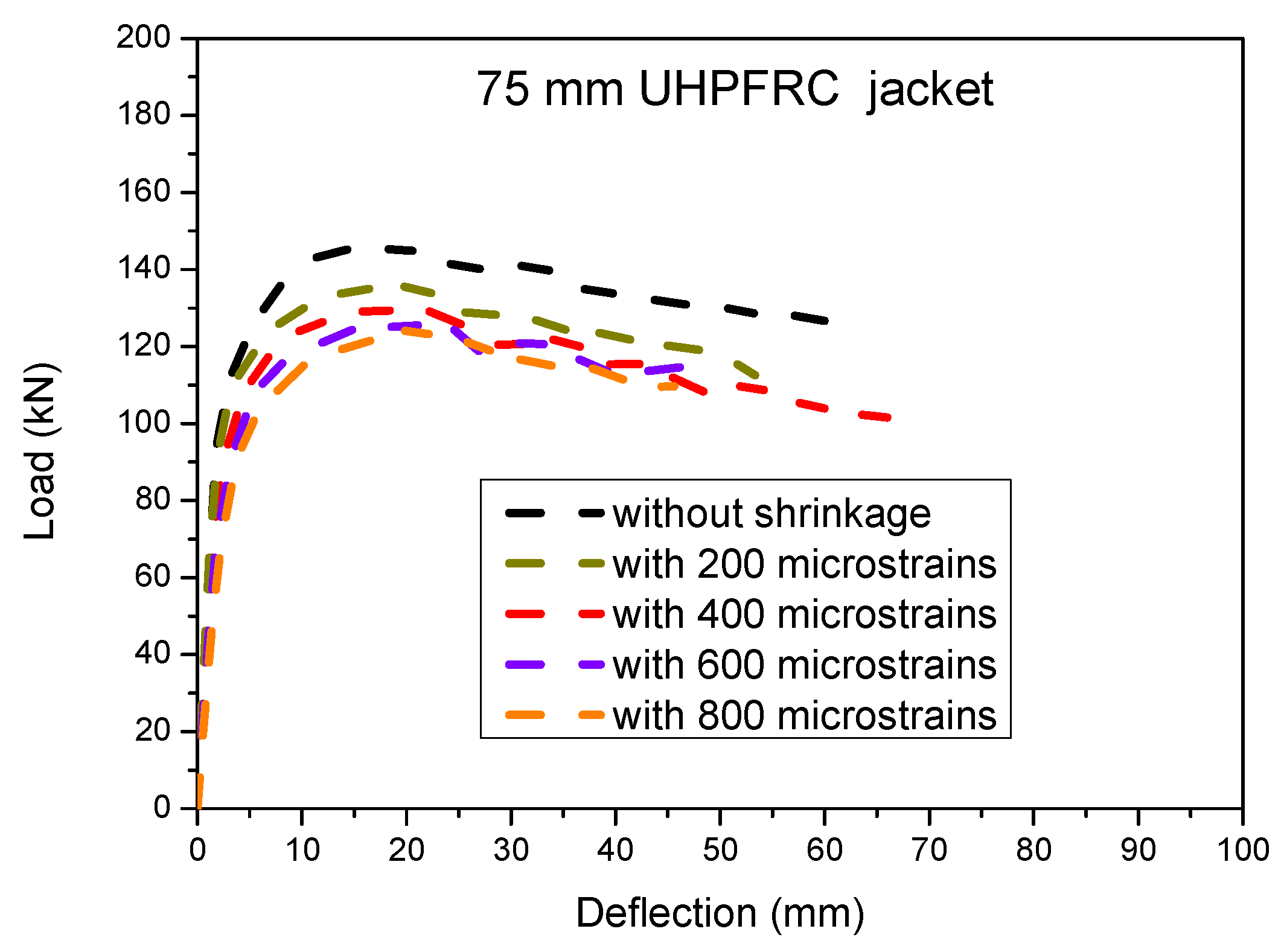
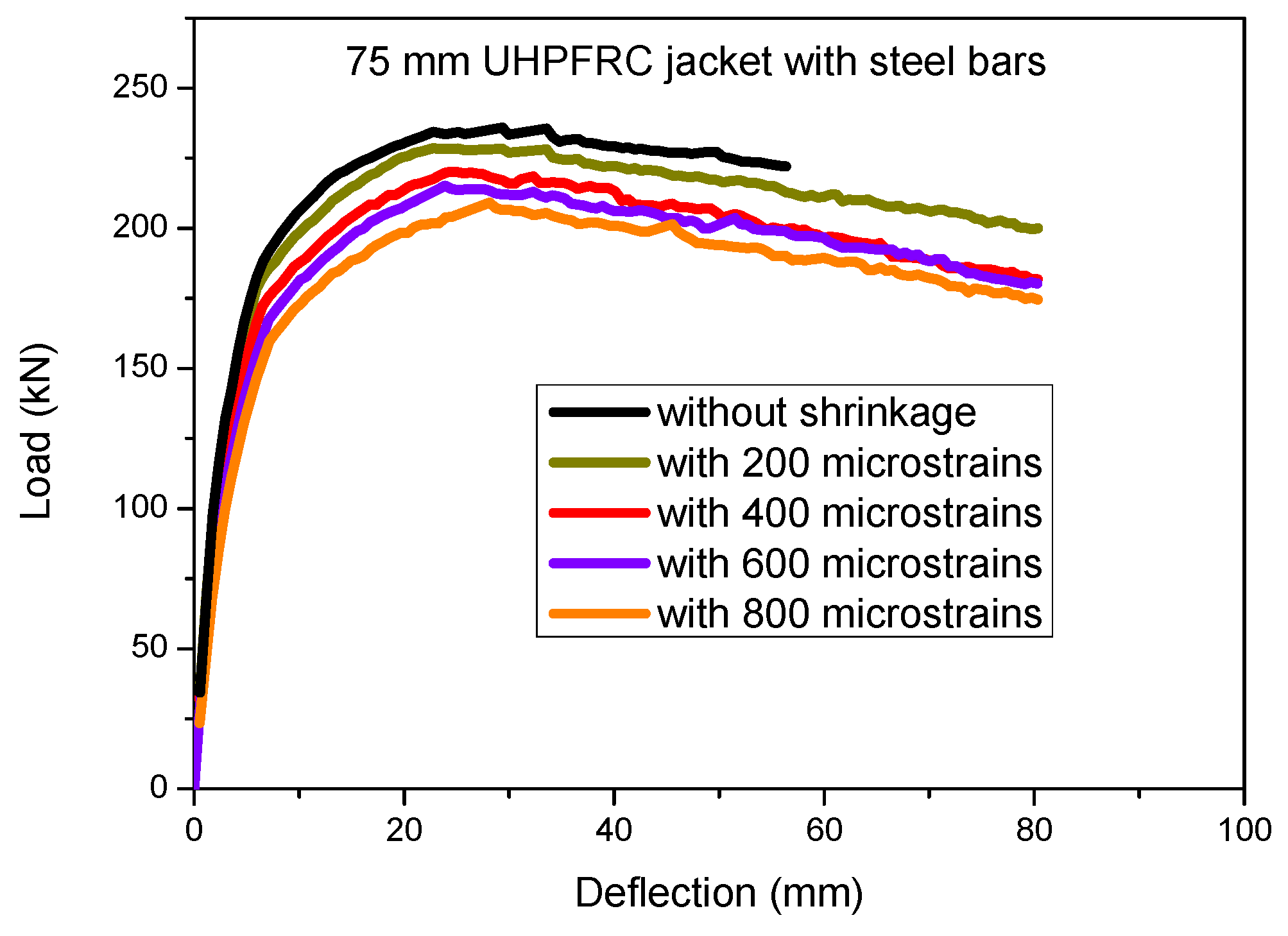

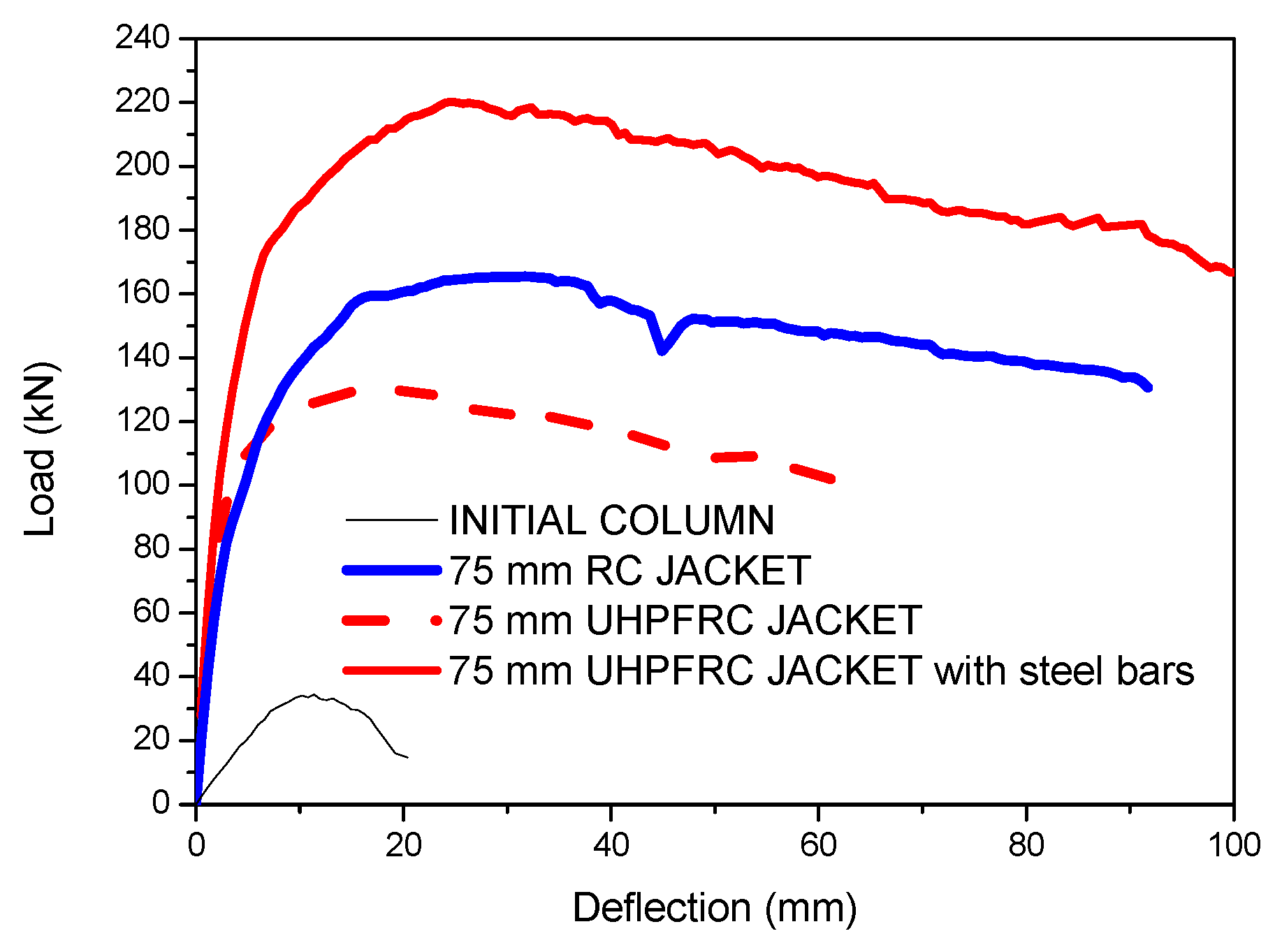

| Material | Mix Proportions (kg/m3) |
|---|---|
| Cement (52.5 N) | 657 |
| GGBS | 418 |
| Silica fume | 119 |
| Silica sand | 1051 |
| Superplasticizer | 59 |
| Water | 185 |
| 3% Steel fibers (13 mm in length and 0.16 mm in diameter) | 236 |
Disclaimer/Publisher’s Note: The statements, opinions and data contained in all publications are solely those of the individual author(s) and contributor(s) and not of MDPI and/or the editor(s). MDPI and/or the editor(s) disclaim responsibility for any injury to people or property resulting from any ideas, methods, instructions or products referred to in the content. |
© 2024 by the authors. Licensee MDPI, Basel, Switzerland. This article is an open access article distributed under the terms and conditions of the Creative Commons Attribution (CC BY) license (https://creativecommons.org/licenses/by/4.0/).
Share and Cite
Lampropoulos, A.; Paschalis, S.; Tsioulou, O.; Dritsos, S. Numerical Investigation of Reinforced Concrete (RC) Columns Strengthened with Ultra-High-Performance Fiber-Reinforced Concrete (UHPFRC) Jackets. Materials 2024, 17, 3380. https://doi.org/10.3390/ma17143380
Lampropoulos A, Paschalis S, Tsioulou O, Dritsos S. Numerical Investigation of Reinforced Concrete (RC) Columns Strengthened with Ultra-High-Performance Fiber-Reinforced Concrete (UHPFRC) Jackets. Materials. 2024; 17(14):3380. https://doi.org/10.3390/ma17143380
Chicago/Turabian StyleLampropoulos, Andreas, Spyridon Paschalis, Ourania Tsioulou, and Stephanos Dritsos. 2024. "Numerical Investigation of Reinforced Concrete (RC) Columns Strengthened with Ultra-High-Performance Fiber-Reinforced Concrete (UHPFRC) Jackets" Materials 17, no. 14: 3380. https://doi.org/10.3390/ma17143380




